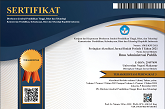Driving Bureaucracy Towards Post NPM: Case Studies And TNA Item Bank Management
(1) Pusat Asesmen dan Pembelajaran
(2) Universitas Indonesia
(*) Corresponding Author
DOI: https://doi.org/10.26858/jiap.v11i1.19344
Abstract
Keywords
Full Text:
PDFReferences
Beckert, J (2010) Institutional isomorphism revisited: Convergence and divergence in institutional change. Sociological Theory, 28(2), 150-166 https://www.jstor.com/stable/25746221
Dunleavy P, Evans M (2019) Australian administrative elites and the challenges of digital-era change. Journal of Chinese Governance 2019, 4(2), 181–200. https://doi.org/10.1080/23812346.2019.1596544
Dunleavy P, Margetts H, Bastow S, Tinkler J (2006). New public management is dead: Long live digital-era governance. Journal of Public Administration Research and Theory: J-PART, 16(3), 467-494 https://www.jstor.org/stable/3840393
Gaus N, Sultan, Basri M (2016) State bureaucracy in Indonesia and its reforms: An overview. International Journal of Public Administration. 40 (8). 658-669 https://doi.org/10.1080/01900692.2016.1186179
Harun H, Mir M, Carter D, An Y, (2019) Examining the unintended outcomes of NPM reforms in Indonesia. Public Money & Management. VOL. 39, NO. 2, 86–94 https://doi.org/10.1080/09540962.2019.1580892
Harun H, Graham P, Kamase HP, Mir M, (2020): A Critical Analysis of the Impacts of Financial Literacy and NPM on Village Funds Initiative in Indonesia, International Journal of Public Administration, https://doi.org/10.1080/01900692.2020.1722165
Margetts H, Dunleavy P (2013) The second wave of digital-era governance: a quasi-paradigm for government on theWeb. Philosophical Transactions of the Royal Society A 371: 20120382. https://dx.doi.org/10.1098/rsta.2012.0382
Max Weber., (1947) The Theory of Social and Economic Organization. New York: Oxford.
Max Weber., (1946) Essays in Sociology. New York: Oxford
Max Weber., (1950) General Economic History. Glencoe: Free Press
Mizruchi MS, Fein LC (1999) The social construction of organizational knowledge: A study of the uses of coercive, mimetic, and normative isomorphism. 653/Administrative Science Quarterly, 44, 653-683. https://doi.org/10.2307/2667051
Muellerleile C, Robertson SL (2018) Digital Weberianism: Bureaucracy, information, and the techno-rationality of neoliberal capitalism. Indiana Journal of Global Legal Studies, 25(1). https://doi.org/10.2979/indjglolegstu.25.1.0187
Prabowo TJW, (2016). Reforms in public sector accounting and budgeting in Indonesia (2003-2015) Confusions in implementation. Journal of Public Budgeting, Accounting & Financial Management Vol. 30 No. 1, 2018 pp. 2-21 Emerald Publishing Limited https://doi.org/10.1108/JPBAFM-03-2018-002
Segev E (2020) Textual network analysis: Detecting prevailing themes and biases in international news and social media. Sociology Compass 2020;e12779: John Wiley & Sons Ltd. 1-14 https://doi.org/10.1111/soc4.12779
Sofyani H, Akbar R, Ferrer RC (2018) 20 years of Performance Measurement System (PMS) implementation in Indonesian local governments: Why is their performance still poor?. Asian Journal of Business and Accounting, 11(1), 2018. https://doi.org/10.22452/ajba.vol11no1.6
Tassabehji R, Hackney R, Popovič A (2016) Emergent digital era governance: Enacting the role of the ‘institutional entrepreneur’ in transformational change. Government Information Quarterly, 33, 223–236. https://dx.doi.org/10.1016/j.giq.2016.04.003
Tian X, Christensen T., (2019). Ambiguous hybridity? Main features of China’s service-oriented government reform. International Journal of Public Sector Management Vol. 33 No. 4, 2020 pp. 419-433 © Emerald Publishing Limited 0951-3558 https://doi.org/10.1108/IJPSM-09-2019-0241
Turner M, Prasojo E, Sumarwono R (2019) The challenge of reforming big bureaucracy in Indonesia. Policy Studies. 1-19. https://doi.org/10.1080/01442872.2019.1708301
Ugyel L (2014) Explaining hybridity in public administration: an empirical case of Bhutan’s civil service. Public Administration and Development, 34, 109–122. https://doi.org/10.1002/pad.1685
Article Metrics
Abstract view : 509 times | PDF view : 112 timesRefbacks
- There are currently no refbacks.
Copyright (c) 2021 Nur Muhammaditya, Sudarsono Hardjosoekarto

This work is licensed under a Creative Commons Attribution 4.0 International License.
Diterbitkan oleh:
Program Studi Ilmu Administrasi Publik
Program Pascasarjana Universitas Negeri Makassar
JIAP Index By:

This work is licensed under a Creative Commons Attribution 4.0 International License.









